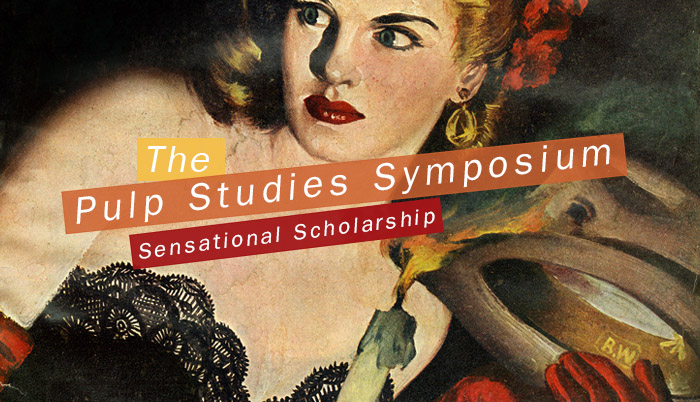Presentation Title
Finding Dorothy Baker and Theodora Keogh: Feminist Recovery and Pulp History
Abstract
Even the most avid readers of women writers are unlikely to know the names Dorothy Baker and Theodora Keogh. Though both of these American authors produced highly original, skilled, and potentially significant novels during their mid-twentieth century careers, they have been mostly forgotten for two primary reasons: first, they are women authors who specialized in works that defied generic boundaries, especially the limits of those genres typically associated with their gender. Equally important is the fact that their most productive writing periods happened to coincide with the heyday of pulp publishing; the continual re-printing of their work in various cheap paperback forms has likely amplified the bias of modern readers and scholars against them. Indeed, while other women writers have been plucked from obscurity by diligent feminist recovery projects, these worthy authors have remained mostly forgotten. Though Baker’s body of work has been partly rediscovered by the venerable New York Review of Book’s press, one of her most significant and controversial works—1943’s Trio—is only available in its various pulp manifestations. Keogh, author of nine novels, has received even less attention—a few blog posts about her life as a Paris expatriate, an occasional mention as a curious footnote to her grandfather Theodore Roosevelt’s life, a couple of novels reprinted by a European press.
Unknown numbers of worthy mid-century American women authors like Baker and Keogh deserve serious reconsideration but remain effectively out of print. That one can lay hands on their work only through fragile copies of pulp editions scoured from used bookstores and online distributers exacerbates their undeserved obscurity. Furthermore, their situation provides a clear warning: as age and mishandling lead more and more of these books to dissolve in the discard pile, we may also lose a significant tradition of women’s writing that has yet to be explored.
The project of recovering forgotten women writers by feminist scholars aligns closely with that of academics who seek to pull pulp authors out of obscurity and reevaluate their literary merit, and thus it is my argument that pulp studies and feminist literary theory have much to offer one another. Feminist criticism has a long, successful history of recovering overlooked authors and developing clear, systematic methods of evaluation that justify these artists’ merit, which might offer a model for the recovery process from which pulp studies could benefit. Conversely, inspired in part by David M. Earle’s claim that pulp is “an excellent place to look for institutionally sanctified subjugation,” I argue that pulp publishing represents one margin to which bias has relegated so many worthwhile but difficult to categorize works by women authors.[1] Yet this fertile repository has not been tapped by feminist scholars, due to many of the same preconceptions that have long plagued evaluations of women’s writing more generally, and thus pulp studies can also offer much to this cohort. Just as women’s work has been deemed lightweight, unskilled, and ephemeral, so too has pulp work been dismissed for its deviations from the highbrow qualities associated with literary value. But now that critics like Earle, among others, have begun offering reinterpretations of the judgments made against pulp publications, feminist critics should also check our own prejudices and turn our attention to this potentially fruitful and vital field.
Baker and Keogh thus offer a useful case study to consider both feminist recovery’s own internal biases but also the way these projects of salvaging underappreciated and neglected writers can offer an object lesson to pulp critics as their work making a case for the rescue of the texts, authors, and editors associated with pulp publishing gathers steam both inside and outside of the academy. In my presentation, I will examine Baker and Keogh’s writing both within the conventions of the pulp genre but also within the larger literary context in which both lived and worked, including that of mid-century women authors, a cohort that has been relatively neglected. Finally, I will place their work within the larger framework of feminist literary history in order to make a case for greater inclusivity in developing a feminist literary canon. To elaborate on these issues, I will focus especially on Baker’s 1943 novel Trio and Keogh’s 1950 novel Meg. Both works use standard conventions of the pulp suspense novel to explore themes more typically associated with avant-garde or modernist fiction, including ruminations on aesthetic values, lesbian relationships, and interpersonal violence. That Baker and Keogh may complicate previous theories about what constitutes “women’s writing” makes their acknowledgement all the more vital.
[1] David M. Earle, Re-covering Modernism (Surrey: Ashgate, 2009) 13.
Finding Dorothy Baker and Theodora Keogh: Feminist Recovery and Pulp History
Even the most avid readers of women writers are unlikely to know the names Dorothy Baker and Theodora Keogh. Though both of these American authors produced highly original, skilled, and potentially significant novels during their mid-twentieth century careers, they have been mostly forgotten for two primary reasons: first, they are women authors who specialized in works that defied generic boundaries, especially the limits of those genres typically associated with their gender. Equally important is the fact that their most productive writing periods happened to coincide with the heyday of pulp publishing; the continual re-printing of their work in various cheap paperback forms has likely amplified the bias of modern readers and scholars against them. Indeed, while other women writers have been plucked from obscurity by diligent feminist recovery projects, these worthy authors have remained mostly forgotten. Though Baker’s body of work has been partly rediscovered by the venerable New York Review of Book’s press, one of her most significant and controversial works—1943’s Trio—is only available in its various pulp manifestations. Keogh, author of nine novels, has received even less attention—a few blog posts about her life as a Paris expatriate, an occasional mention as a curious footnote to her grandfather Theodore Roosevelt’s life, a couple of novels reprinted by a European press.
Unknown numbers of worthy mid-century American women authors like Baker and Keogh deserve serious reconsideration but remain effectively out of print. That one can lay hands on their work only through fragile copies of pulp editions scoured from used bookstores and online distributers exacerbates their undeserved obscurity. Furthermore, their situation provides a clear warning: as age and mishandling lead more and more of these books to dissolve in the discard pile, we may also lose a significant tradition of women’s writing that has yet to be explored.
The project of recovering forgotten women writers by feminist scholars aligns closely with that of academics who seek to pull pulp authors out of obscurity and reevaluate their literary merit, and thus it is my argument that pulp studies and feminist literary theory have much to offer one another. Feminist criticism has a long, successful history of recovering overlooked authors and developing clear, systematic methods of evaluation that justify these artists’ merit, which might offer a model for the recovery process from which pulp studies could benefit. Conversely, inspired in part by David M. Earle’s claim that pulp is “an excellent place to look for institutionally sanctified subjugation,” I argue that pulp publishing represents one margin to which bias has relegated so many worthwhile but difficult to categorize works by women authors.[1] Yet this fertile repository has not been tapped by feminist scholars, due to many of the same preconceptions that have long plagued evaluations of women’s writing more generally, and thus pulp studies can also offer much to this cohort. Just as women’s work has been deemed lightweight, unskilled, and ephemeral, so too has pulp work been dismissed for its deviations from the highbrow qualities associated with literary value. But now that critics like Earle, among others, have begun offering reinterpretations of the judgments made against pulp publications, feminist critics should also check our own prejudices and turn our attention to this potentially fruitful and vital field.
Baker and Keogh thus offer a useful case study to consider both feminist recovery’s own internal biases but also the way these projects of salvaging underappreciated and neglected writers can offer an object lesson to pulp critics as their work making a case for the rescue of the texts, authors, and editors associated with pulp publishing gathers steam both inside and outside of the academy. In my presentation, I will examine Baker and Keogh’s writing both within the conventions of the pulp genre but also within the larger literary context in which both lived and worked, including that of mid-century women authors, a cohort that has been relatively neglected. Finally, I will place their work within the larger framework of feminist literary history in order to make a case for greater inclusivity in developing a feminist literary canon. To elaborate on these issues, I will focus especially on Baker’s 1943 novel Trio and Keogh’s 1950 novel Meg. Both works use standard conventions of the pulp suspense novel to explore themes more typically associated with avant-garde or modernist fiction, including ruminations on aesthetic values, lesbian relationships, and interpersonal violence. That Baker and Keogh may complicate previous theories about what constitutes “women’s writing” makes their acknowledgement all the more vital.
[1] David M. Earle, Re-covering Modernism (Surrey: Ashgate, 2009) 13.


